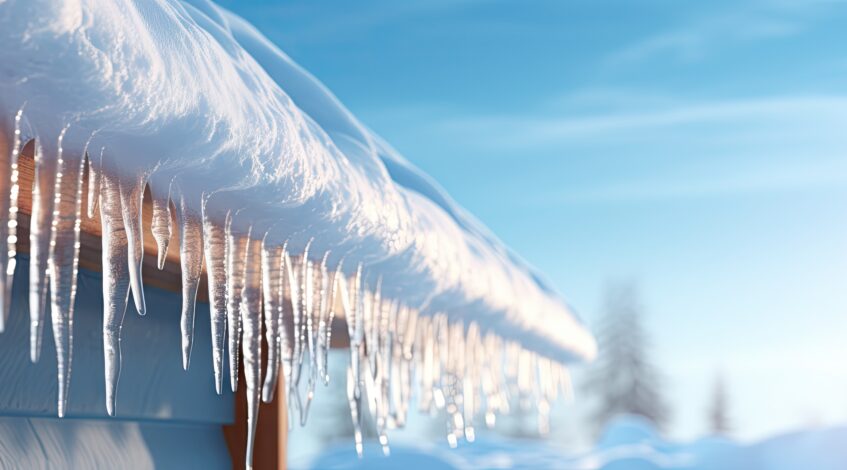Ice dams are a common winter hazard that can cause significant damage to your roof, gutters, and home. They form when melting snow refreezes at the edge of your roof, blocking water from draining properly. This trapped water can seep into your home, leading to leaks, mold, and structural damage. Fortunately, with proactive gutter care and proper preparation, you can prevent ice dams and keep your home safe throughout the winter season. Here’s how.
What Are Ice Dams and Why Do They Form?
Ice dams occur when heat from your attic warms your roof, causing snow to melt. As the water flows down the roof and reaches the colder eaves, it refreezes, forming a dam of ice. This dam prevents additional melting snow from draining properly, forcing water to pool behind it.
Key Factors Leading to Ice Dams:
- Poor Attic Insulation: Allows heat to escape, warming the roof.
- Inadequate Ventilation: Traps warm air in the attic.
- Clogged Gutters: Prevents water from draining, exacerbating ice buildup.
How Ice Dams Damage Your Home
Ice dams can cause a variety of problems, including:
- Roof leaks and water damage
- Warped or rotted fascia and soffits
- Damaged gutters and downspouts
- Stained ceilings and walls
- Mold and mildew growth inside your home
Winter Gutter Care Tips to Prevent Ice Dams
1. Clean Gutters Before Winter
Why It’s Important:
Clogged gutters trap water, which can freeze and contribute to ice dam formation.
How to Do It:
- Remove leaves, twigs, and debris from gutters and downspouts.
- Flush the system with water to ensure proper flow.
- Install gutter guards to minimize debris buildup during the season.
2. Ensure Proper Attic Insulation
Why It’s Important:
Good insulation keeps warm air in your living space, preventing it from escaping to the roof.
How to Do It:
- Check your attic for gaps or thin insulation.
- Add additional insulation as needed, particularly around vents, chimneys, and light fixtures.
- Use weatherstripping or caulk to seal gaps that allow warm air to escape.
3. Improve Attic Ventilation
Why It’s Important:
Ventilation helps regulate attic temperature, keeping your roof cold and reducing the likelihood of ice dams.
How to Do It:
- Install ridge vents, soffit vents, or gable vents to promote airflow.
- Ensure existing vents are unobstructed by insulation or debris.
4. Install Heat Cables
Why It’s Important:
Heat cables or heat tape can be installed along the roof edge or in gutters to melt snow and ice, preventing dams from forming.
How to Do It:
- Follow the manufacturer’s instructions to attach heat cables to your roof or gutters.
- Turn them on during heavy snow or freezing conditions for maximum effectiveness.
5. Remove Snow from Your Roof
Why It’s Important:
Clearing snow minimizes the amount of melting water that can contribute to ice dams.
How to Do It:
- Use a roof rake with a long handle to safely remove snow from the ground.
- Avoid using sharp tools that could damage shingles.
6. Inspect and Repair Gutters and Roof
Why It’s Important:
Damaged gutters and roofs are more susceptible to ice dams and water damage.
How to Do It:
- Check for loose, sagging, or cracked gutters and repair them before winter.
- Inspect your roof for damaged shingles, flashing, or leaks, and address any issues promptly.
7. Create Water Escape Channels
Why It’s Important:
If an ice dam does form, escape channels can help drain the water and reduce damage.
How to Do It:
- Use warm water or a calcium chloride ice melt product to carve channels through the dam.
- Avoid using rock salt, as it can damage your roof and gutters.
Proactive Steps for Long-Term Ice Dam Prevention
- Install Ice and Water Shield:
Apply a waterproof membrane under shingles along the roof’s edge to protect against leaks. - Upgrade Gutters:
Consider seamless gutters that reduce the risk of water pooling and freezing. - Add Drip Edges:
These direct water away from the roof edge, preventing it from refreezing. - Schedule Professional Inspections:
Have a roofing or gutter specialist assess your system annually to ensure it’s winter-ready.
When to Call a Professional
If ice dams have already formed or you’re unable to safely address the issue, it’s best to call a professional. They can:
- Safely remove ice dams using steam or other specialized equipment
- Assess and repair any damage caused by ice dams
- Improve your home’s insulation and ventilation systems
Conclusion
Preventing ice dams starts with proactive gutter maintenance, proper insulation, and adequate attic ventilation. By taking these steps, you can protect your home from winter water damage and enjoy peace of mind throughout the colder months.
Need help winterizing your gutters? Contact a professional today, or explore our blog for more home maintenance tips!

